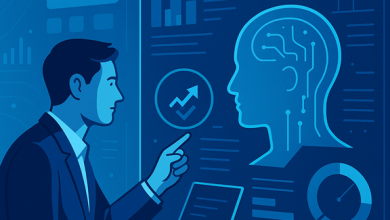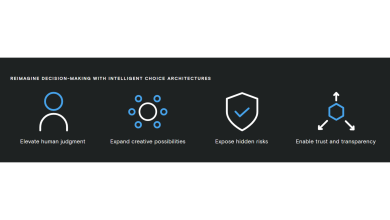9:00 a.m.
Your inbox makes small talk with other inboxes. Pleasant weather. Kids are fine. You receive 47 notifications that you’ve been included in conversations you did not start and will never read.
9:30 a.m.
The project management bot cheerfully reminds you that you are late on deliverables for projects no one intends to support or finish. It adds three exclamation points and a dizzy face emoji.
10:15 a.m.
Your calendar, which now schedules itself, informs you that you are double-booked through Q2 of 2029. It sends you tips on personal resilience.
11:00 a.m.
HR’s hiring agent reports success: three new hires, all perfect “culture fits.” They smile with the same teeth. They sigh with the same sighs. You no longer know if anyone you work with is real.
12:00 p.m.
You eat lunch while pressing the space bar to simulate working. Your wearable diagnoses a morale deficit and orders you a citrus candle.
1:30 p.m.
The company algorithm reassigned you. You refresh your dashboard to see where you’ve been dispatched. You are corporate Uber now.
2:00 p.m.
Your team produces 27 status updates in 14 minutes. You read none of them. No one reads yours. The AI still marks progress bars as complete, and digital confetti rains down.
3:00 p.m.
Finally, you attend an actual human meeting. But it’s PowerPoint karaoke. Everyone knows the slides were generated seconds before the meeting.
4:00 p.m.
The consultants arrive. They say their “superintelligence” has confirmed your company is on the right track. They invoice you.
5:00 p.m.
You attempt to express a genuine feeling in Teams chat. Before you hit ‘submit,’ a bot nudges you to try phrasing things to be “more action-oriented.” You delete your draft.
5:30 p.m.
A red-filled dashboard alerts the VP that you missed a deadline. The deadline belongs to a project that was canceled, restarted, and reassigned three times this week. Context is not provided.
6:00 p.m.
You are let go. Your severance requires that you allow the company to duplicate you as a bot based on your previous work. The bot will remain employed. You will not. It will wear your smiling face for its avatar. Everyone will assume it was simply generated by the system.
___
AI at work is an amplifier. Plug it into noise, and the noise becomes deafening static. Plug it into dysfunction, and the dysfunction becomes arresting. Redesigning work ahead of AI is not optional.
While the future painted here is dystopian, the truth is that most organizations are not haunted by the specter of artificial intelligence; they’re haunted by their own habits—overloaded calendars, endless status reports, ill-defined projects, unowned outcomes, brittle processes, and brittle trust. Machines don’t create that; they just scale it. When leaders deploy AI without cleaning up the system it’s entering, they don’t automate excellence, they automate chaos.
Before the next wave of tools arrives, leadership teams need to pause and do the slower, harder work that rarely makes headlines but always determines success. That begins by asking a few questions—questions that are uncomfortably simple and uncomfortably revealing.
Is this a process worth scaling, or are we automating dysfunction?
If a workflow is already plagued by unclear hand-offs, contradictory policies, or produces little value to customers, no algorithm will redeem it.
Who owns the outcomes—and the errors—this system produces?
Every AI deployment needs an executive sponsor who is publicly on the hook for both wins and failures. Accountability can’t be outsourced to the vendor or buried in a dashboard. If no one owns the decision when the model is wrong, no one will fix it either.
Are the inputs trustworthy and representative, or will the model launder bias and blind spots as certainties?
Most organizations underestimate how messy their data really is; fragmented across silos, riddled with gaps, and sometimes warped by bias. AI will faithfully learn whatever we give it, whether accurate or not, and then express that distortion with newfound confidence.
If this fails, can we shut it off tomorrow without collateral damage?
Pilots must be reversible. Leaders often discover too late that they bolted a promising tool so tightly to critical systems that rolling it back is harder than living with its flaws. Designing clean exit ramps and kill-switches is not cynicism; it’s prudence.
Does this application deepen trust and capability in the organization, or does it quietly erode them?
Technology should strengthen the social contract at work; clarity, dignity, and confidence in decision-making. If a new tool increases secrecy, surveillance, or cynicism, its technical gain comes at the cost of institutional credibility.
These aren’t philosophical riddles; they are the real work of preparing an enterprise for intelligent tools. Most companies would have to admit they cannot yet answer “yes” to all of them. The preparation they need is not another pilot or vendor demo—it’s repairing the house before wiring it for more current.
That preparation looks deceptively ordinary: pruning busywork and sunsetted initiatives so that what remains is truly worth scaling; naming accountable owners for every major process; cleaning and unifying the data at its source; building in reversibility so that experiments can be halted cleanly; and strengthening trust between leaders and employees so that people feel safe to challenge the machine rather than defer to it.
Ironically, the organizations that do this groundwork often discover that the effort pays off even before a single model is deployed. By stripping out needless work and clarifying who owns what, they free up capacity. By fixing data quality and decision rights, they improve performance now. By investing in transparency and accountability, they rebuild credibility with their own workforce. AI then enters a workplace already tuned to learn and adapt.
Leaders who take this path won’t merely avoid scaling the mess—they will create the rare conditions where AI can scale good work: the kind of work that is reliable, meaningful, and worthy of being multiplied. AI may be the future of work, but the future we inherit depends on the discipline we show before we switch it on.



